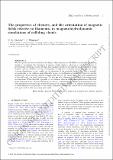Files in this item
The properties of clusters, and the orientation of magnetic fields relative to filaments, in magnetohydrodynamic simulations of colliding clouds
Item metadata
| dc.contributor.author | Dobbs, C L | |
| dc.contributor.author | Wurster, J | |
| dc.date.accessioned | 2021-02-09T10:30:07Z | |
| dc.date.available | 2021-02-09T10:30:07Z | |
| dc.date.issued | 2021-01-23 | |
| dc.identifier | 272795388 | |
| dc.identifier | 6ae7a6e5-cefb-43d1-84dc-9471dbf64981 | |
| dc.identifier | 000648997200053 | |
| dc.identifier | 85117444372 | |
| dc.identifier.citation | Dobbs , C L & Wurster , J 2021 , ' The properties of clusters, and the orientation of magnetic fields relative to filaments, in magnetohydrodynamic simulations of colliding clouds ' , Monthly Notices of the Royal Astronomical Society . https://doi.org/10.1093/mnras/stab150 | en |
| dc.identifier.issn | 0035-8711 | |
| dc.identifier.other | Jisc: b2d7a5e4f55647bd927d9cc349bcdc26 | |
| dc.identifier.other | ORCID: /0000-0003-0688-5332/work/88731481 | |
| dc.identifier.uri | https://hdl.handle.net/10023/21391 | |
| dc.description | Funding: LD acknowledges funding from the European Research Council for the Horizon 2020 ERC consolida-tor grant project ICYBOB, grant number 818940. | en |
| dc.description.abstract | We have performed Smoothed Particle Magneto-Hydrodynamics (SPMHD) calculations of colliding clouds to investigate the formation of massive stellar clusters, adopting a timestep criterion to prevent large divergence errors. We find that magnetic fields do not impede the formation of young massive clusters (YMCs), and the development of high star formation rates, although we do see a strong dependence of our results on the direction of the magnetic field. If the field is initially perpendicular to the collision, and sufficiently strong, we find that star formation is delayed, and the morphology of the resulting clusters is significantly altered. We relate this to the large amplification of the field with this initial orientation. We also see that filaments formed with this configuration are less dense. When the field is parallel to the collision, there is much less amplification of the field, dense filaments form, and the formation of clusters is similar to the purely hydrodynamical case. Our simulations reproduce the observed tendency for magnetic fields to be aligned perpendicularly to dense filaments, and parallel to low density filaments. Overall our results are in broad agreement with past work in this area using grid codes. | |
| dc.format.extent | 2795292 | |
| dc.language.iso | eng | |
| dc.relation.ispartof | Monthly Notices of the Royal Astronomical Society | en |
| dc.subject | General, ISM: clouds | en |
| dc.subject | Stars: formation | en |
| dc.subject | Galaxies: star clusters: general | en |
| dc.subject | QB Astronomy | en |
| dc.subject | QC Physics | en |
| dc.subject | NDAS | en |
| dc.subject.lcc | QB | en |
| dc.subject.lcc | QC | en |
| dc.title | The properties of clusters, and the orientation of magnetic fields relative to filaments, in magnetohydrodynamic simulations of colliding clouds | en |
| dc.type | Journal article | en |
| dc.contributor.institution | University of St Andrews. School of Physics and Astronomy | en |
| dc.identifier.doi | https://doi.org/10.1093/mnras/stab150 | |
| dc.description.status | Peer reviewed | en |
This item appears in the following Collection(s)
Items in the St Andrews Research Repository are protected by copyright, with all rights reserved, unless otherwise indicated.

